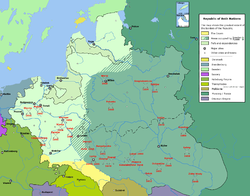Russo-Polish War 1654–1667
Smolensk (1654) - Homel (1654) - Shkloŭ (1654) - Schepielewitsche (1654) - Dubroŭna (1654) - Stary Bykhaw (1654) - Wizebsk (1654) - Ochmatiw (1655) - Mogilew (1655) - Vilnius (1655) - Lviv (1655) - Horodok (1655) - Oserna (1655) - Brest (1655)
Kiev (1658) - Werki (1658) - Varva (1659) - Kovno (1658 - 1659) - Medilas (1659) - Stary Bychau (1659) - Konotop (1659) - Mohyliw-Podilskyj (1660) - Lyachawitsy (1660) - Baryssau (1660) - Polonka (1660) - Mogilew (1660) - Lubar (1660) - Slobodyschtsche (1660) - Basja (1660) - Chudniv (1660) - Druja (1661) - Kuschliki (1661) - Vilnius (1661)
Hluchiw (1664) - Pirogovskaya (1664) - Mglin (1664) - Vitebsk (1664) - Schklou (1664) - Stavyshche (1664) - Ilūkste (1665) - Daugavpils (1666)
The Russo-Polish War 1654–1667 began after Tsarism Russia came to the aid of the Ukrainian Cossacks as a result of the Treaty of Perejaslav , who had been fighting against Polish supremacy for six years in the course of the Khmelnytskyi Uprising . It was another outbreak of the centuries-old rivalry for the Ruthenian territories, which Russia, for historical, dynastic, religious and cultural reasons, considered an alien part of its territory.
Course of war
The war was extremely changeable, although it took place almost entirely in the area belonging to Poland-Lithuania. First, in 1654, Russia was finally able to conquer Smolensk from the Poles, which had been in Polish hands since the time of turmoil and had been besieged unsuccessfully in the war from 1632 to 1634 . After that, the Russian- Ukrainian army was able to win several more battles and advance as far as Lublin in Poland proper. However, when Sweden invaded Poland at the same time , both sides concluded an armistice in the Treaty of Niemież in order to fight against the threatening Swedish supremacy. After the Swedes were driven out of Poland, new hostilities began in 1659, which were more successful for the Poles, motivated by the victory over Sweden. After some of the Cossacks changed sides under Hetman Iwan Wyhowskyj , the Russian army was defeated by Poles, Cossacks and the Crimean Tatars at Konotop on July 8, 1659 , which, however, exacerbated the tensions within the Cossack ranks and led to the early overthrow of Wyhowskyj. Poland was able to push Russia back from Belarus and Lithuania, but ultimately was unable to advance because of internal conflicts and the severe defeat at Hluchiw .
Result

The stalemate culminated in the Treaty of Andrussovo and ultimately in the "Eternal Peace" of 1686 . The "left bank" Ukraine, east of the Dnepr and Kiev passed into Russian possession. This was the beginning of the decline of the Polish-Lithuanian state, which lost more and more areas in the course of the 18th century until it between the great powers divided was. For Russia, however, the annexation of eastern Ukraine marked the beginning of the rise to a major European power.
See also
Individual evidence
- ^ Paul Robert Magocsi: A history of Ukraine. 2nd printing. University of Washington Press, Seattle WA 1997, ISBN 0-295-97580-6 , p. 225.
- ^ Gotthold Rhode : History of Poland. An overview . 3rd edition, Wissenschaftliche Buchgesellschaft (WBG), Darmstadt 1980, ISBN 3-534-00763-8 , p. 282.
- ↑ Christoph Schmidt: Russian history 1547-1917 (= Oldenbourg floor plan of history. Vol. 33). Oldenbourg, Munich 2003, ISBN 3-486-56705-5 , p. 26f.
literature
- Александр Витальевич Малов: Русско-польская война 1654–1667 гг. Цейхгауз, Москва 2006, ISBN 5-94038-111-1 .

